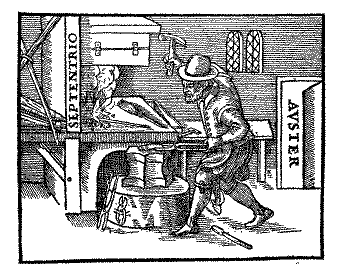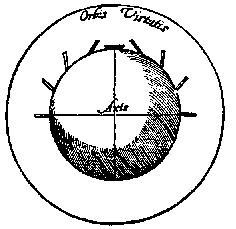|
[an error occurred while processing this directive]
A Millennium of Geomagnetism
2. Early Discoveries and William Gilbert
|
|
Table of Contents
Chronology of Geomagnetism References: A-G References: H-P References: Q-Z Back to the index page 2. Early discoveries
The year 2000 was an important anniversary in geophysics. It marked 400 years since William Gilbert published in London his book De Magnete (Latin for "On the Magnet") [Gilbert, 1600; see also Barraclough, 2000; Schröder, 2000; Chapman, 1944; Watson, 1944], proposing among other things that the Earth itself was a giant magnet, thus explaining the strange directivity of the compass needle (Figure 1). See also historical appendix given by Chapman and Bartels [1940], chapter 26 "Historical Notes," pp. 898-937. It may also be, very approximately, the 1000th anniversary of the discovery of the magnetic compass. The ancient Greeks knew about "lodestones" (or loadstones), rare natural magnets, with the power to attract iron [Mitchell, 1946]. One site where such stones were found was near the city of Magnesia in Asia Minor (now Turkey), and from that (perhaps) came the term "magnetism." However, it may have been an unknown Chinese scholar around the year 1000 [Mitchell, 1932; Knapp, 1962] who first placed a lodestone on a "boat" floating in a bowl of water and observed that, wherever and whenever the experiment was performed, the boat always rotated to face south (though some claims date this Chinese discovery as much as 1000 years earlier). The magnetic force merely rotated the needle, it did not pull it bodily southwards, or in any other direction. Apparently the Chinese also knew steel needles could be permanently magnetized, for Shon Kua (1030-93) wrote "fortune tellers rub the point of a needle with the stone of a magnet in order to make it properly indicate the south." Acording to Andrade [1958; see also Smith, 1992] the earliest European mention of magnetizing iron by having it "touched by a lodestone" dates to about 1200. The discovery spread from China to Europe, and it would be hard to imagine the great sea voyages of Da Gama, Columbus and Magellan without its help. The magnetic compass also found another use: small folding personal sundials, timepieces that needed to be aligned northwards to work properly. But the phenomenon itself was a mystery. According to some reports, helmsmen on British ships were forbidden from eating garlic (on pain of flogging), because of the irrational belief (dating back to Pliny) that the pungent fumes destroyed the magnetic power and thus could disable the compass. This brief history tries to tell the story of the compass needle and its more sophisticated successors, from those early days to the present age. It avoids mathematics and fine details, and also glosses over the details of paleomagnetism, which is outside this writer's expertise; instead, it seeks a synoptic overview, a broad outline of the subject, referring readers interested in more detailed or technical aspects to articles and books; more general expositions may be found in the books byAczel [2001]. Vershuur [1993] and Livingston [1996] . The author has also set up on his world-wide web domain a related set of web pages, with Spanish, German and French translations, at http://www.phy6.org/earthmag/demagint.htm,. We know from Alexander Neckam (1157-1217), a monk at St. Albans, that by the year 1187 magnetic needles were being mounted on pivots, free to rotate towards any horizontal direction like modern compass needles [Mitchell, 1932] . That design is also mentioned in a 1269 letter by the Frenchman Petrus Peregrinus (Pierre Pelerin de Maricourt), who conducted some simple experiments on magnetism. Wrought iron is "magnetically soft" and loses its magnetism when removed from the lodestone, but high-carbon steel can remain permanently magnetized. The traditional way to make a compass was to fashion a flat steel needle and balance it horizontally on a pivot, then magnetize it by stroking with a lodestone. But a strange thing was observed: after the needle became magnetic, its north-pointing end always slanted down, as if it had gained weight. Its tip had to be snipped off (or a counterweight attached) to maintain the balance. The slant of a balanced needle after it was magnetized was noted by Georg Hartmann in 1544 [Chapman and Bartels, 1940, sect. 26.5]. His observation was recorded in a letter found in the Königsberg archives, only discovered in 1831.
Note: the preceding 3 sentences replace incorrect text in the original article, which suggested that Norman measured dip by a needle like the one in Figure 2.
The other discovery of those early years was that even the horizontal part of the force was not directed exactly northward, but usually varied by a few degrees from true north (i.e. celestial north, derived from the motion of the Sun and stars), an angle now known as the declination [Mitchell, 1937]. Compass-builders rotated their dials to compensate for the discrepancy, so that a compass used in (say) the Baltic was calibrated differently from one used in the Mediterranean. 3. William Gilbert This was the scene when William Gilbert (1544?-1603) developed his interest in magnetism. A distinguished doctor, president of the Royal College of Physicians [Langdon-Brown, 1944], Gilbert set out around 1581 to find all he could about magnetism--from books, experiments and observations. In the process he discovered or confirmed all the main properties of permanent magnetism--the way poles re-arranged themselves when a magnet was broken (previously noted by Petrus Peregrinus), the way magnetism was induced in iron placed next to a magnet, how a heated bar of iron lost its magnetism (though the attraction itself could cross a flame), and how a hot bar of steel, pounded by a blacksmith as it cooled while aligned in a north-south direction, became weakly magnetized, capturing the prevailing field of the Earth (Figure 3).
Gilbert also studied other types of attraction, especially the attraction of straws and other light objects to certain materials, after these were lightly rubbed with cloth or fur. One such substance was amber, fossilized pine pitch, called elektron by the Greeks, who already knew of its attractive properties. Gilbert therefore named this the "electrick force" and studied its differences from magnetic attraction--e.g. its susceptibility to humidity. He did not note that two distinct types of electric charge existed, and also puzzled over the attraction between droplets of water, which tended to fuse together, a process now attributed to surface tension.
Gilbert guessed that the reason the compass needle pointed north was that the Earth itself was a giant magnet. He supported his hunch by a simple experiment. He constructed a scale model of a magnetic Earth, a magnetized sphere he named the "terrella" (little Earth), and by sliding a small compass around its surface (or placing it in different positions next to a compass), reproduced not only the observed northward-pointing properties, but also the dip angle (Figure 4).
He also believed that the close proximity of magnetic north and true north was no accident--that the Earth's rotation around its axis stemmed from its magnetism. In Gilbert's age, his claim that the Earth was not the immovable center of the universe--and his strong support, voiced in his book, of the theory of Copernicus--were, in some circles at least, articles of heresy. Edward Wright, in introducing the book, tried to blunt the charge by writing
Still, some copies of "De Magnete" had the offending pages torn out. Galileo, who highly praised the book, obtained his copy as a gift from "a peripatetick philosopher of great fame, as I believe, to free his library of its contagion." Today "De Magnete" stands as a benchmark on the boundary between medieval scholarship--mystical, citing claims of accepted authorities without bothering to check them--and the modern observational approach. It rewards the reader with delightful nuggets, quite different from the impersonal prose of today's journals. Commenting on attempts to use magnetism for generating perpetual motion, such as the one made Petrus Peregrinus, Gilbert wrote:
If magnetism and rotation went together, why did a small "declination" angle (Gilbert called it "variation") exist between true north and magnetic north? Gilbert ingeniously proposed that if the Earth were a perfect sphere, the two directions would indeed be the same. However, the Earth's shape is not quite spherical: continents rise up, while the oceans are nestled in deep gashes. Since Gilbert attributed magnetic attraction to the mass of the Earth (but not, apparently, to the water filling the oceans) he proposed that the elevated portions added to the pull, while the gashes decreased it. He therefore suggested that the compass needle near the eastern and western edges of the Atlantic Ocean would be deflected towards the nearby continents--as was indeed observed at that time. Just to make sure, though, Gilbert also verified the effect experimentally, using a terrella that had "a certain part corroded to resemble the Atlantic or great Ocean." He found that the needle was deflected away from the gash (but since the depth of the ocean basins is less than 1/1000 of the Earth's radius, this was probably not a valid modeling). Halley (section 4) later found the opposite effect occurred near Brazil.
Because continents and oceans do not shift over the historical time scale, Gilbert confidently predicted that magnetic declination would not change:
|
Next Stop: 3. Halley
Back to the Master List
Author and Curator: Dr. David P. Stern
Mail to Dr.Stern: earthmag("at" symbol)phy6.org
Last updated 31 January 2003




